“Glass blowers in the Josephinenhütte.“
I just do not have the time. My web site was really started as an informational site for beginning beer stein collectors that would be looking for the info and not the general public. My So if one put in “Wood Steins” or “Hand painted steins,” it
“Smith’s Museum and Tavern” is happy to have acquired a few “Josephinenhütte” glass drinking vessels for its collection and perhaps for the reader’s drinking vessels’s reference file and visual enjoyment.
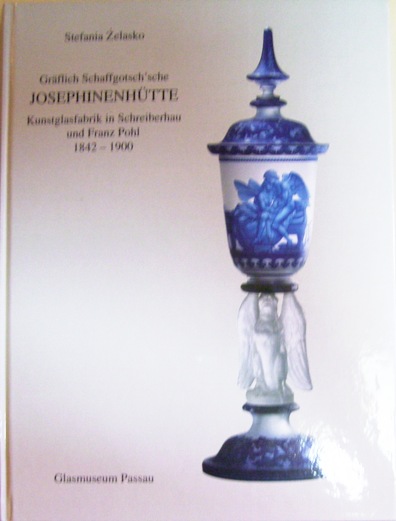
“JOSEPHINENHÜTTE” –
(Full title = “Gräflich Schaffgotsch’sche JOSEPHINENHÜTTE Kunstglasfabrik in Schreiberhau und Franz Pohl 1842-1900”)
This well documented and illustrated book recently was published by the Glassmuseum, Passau. I used it in determining the probability of drinking vessels being made by that firm within the Smith collection: “From Which To Drink.” As none of these pieces are signed, their attribution may be up for questioning from those that know more than I do. (sls)
Passau is strategically located in Germany, at the confluence of the Danube, Inn, and Ilz rivers, on the Austrian border. Originating as the Celtic settlement of Bojodurum, it was later the site of a Roman camp, Castra Batava, and was made an episcopal see in 739. The bishops became princes of the Holy Roman Empire in 1217 and ruled Passau until 1803, in spite of citizens’ revolts for municipal freedom. Fires in 1662 and 1680 caused great damage, and subsequent rebuilding gave the town a distinctly Baroque character.
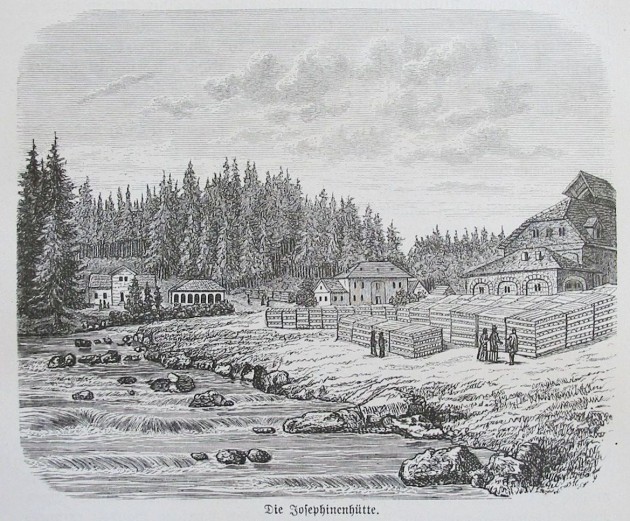
Josephinenhütte’s physical plant in 1834.
SERVERS
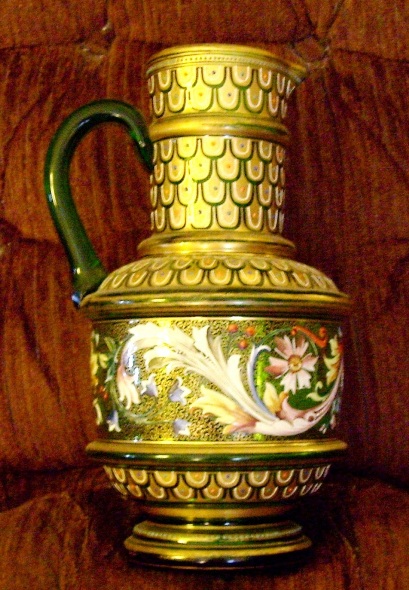
A very highly enameled serving stein / jug. 11 3/4 inches tall. Circa 1850. The pattern on this server has been credited by worldwide glass dealers ,and not only just on eBay, to just about every German and Bohemian glass maker that ever was. For similar examples, see Ill. 271, page 259. [FWTD]
FOOTED BEAKER
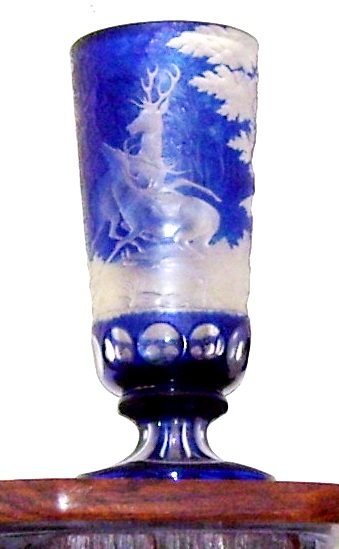
Blue glass, cut-to-clear, 8 Inches tall. Circa 1850. For similar examples, see Ill. 145, page 186; and Ill. 170, page 200.[FWTD]
BEER STEIN – SET ON LID TYPE
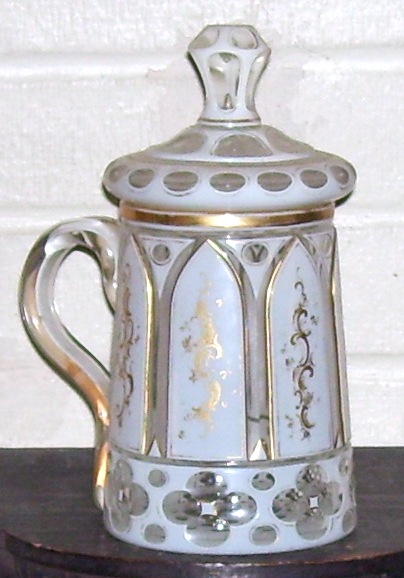
White glass cut-to-clear glass. 8.5 Inches tall. Dated 1853 on one of the small cut circles on the lid.For an “almost exact” example with the Gothic arches, see Ill. 117, page 173. [FWTD]
ROEMERS
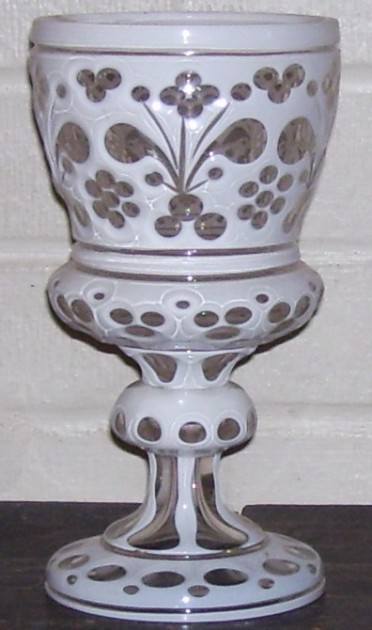
White glass cut to clear glass. 8 Inches tall. Circa 1850. For a similar example, see Ill. 116, page 173.[FWTD]

Clear glass roemers with twisted ribbon stems, with engraved animal scenes; this one with a running deer. These come in many sizes. Circa 1880. Shown: 11 inches tall; FWTD]
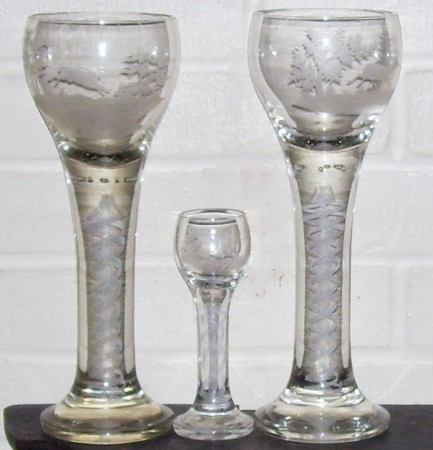
The left scene shows an engraved running rabbit. The middle one, at 6 inches tall, would be used for a schnapps glass; it has an engraved grouse. A running deer, different from above is on the right one. Designed by Siegfried Haerte.(So says an Argentina eBay seller.) [FWTD]
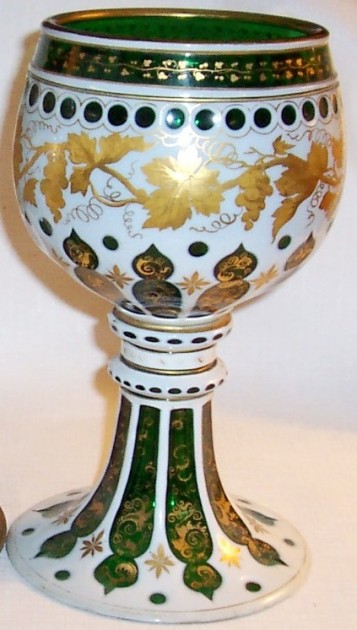
▲ – Gold on white glass, cut-to-green. 9.5 Inches. Circa 1860-65. For similar examples for both of these roemers, see Ill. 161, page 195; Ill.193, page 212; and Ill.201, page 217. [FWTD]
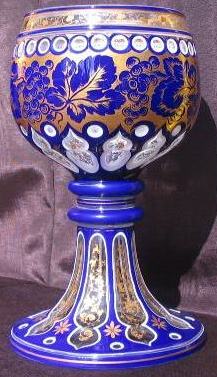
Gold over blue glass over white glass, both cut-to-clear. 9.5 Inches tall. Circa 1860-65. For similar examples for both of these roemers, see Ill. 161, page 195; Ill.193, page 212; and Ill.201, page 217. [FWTD]
BEAKERS
A SET OF FOUR, WHITE GLASS CUT-TO-CLEAR, WITH RUBY CUT-TO-CLEAR PANELS, THREE PANELS EACH.
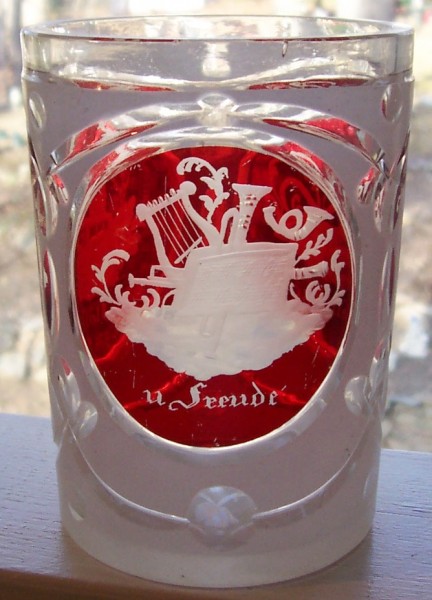
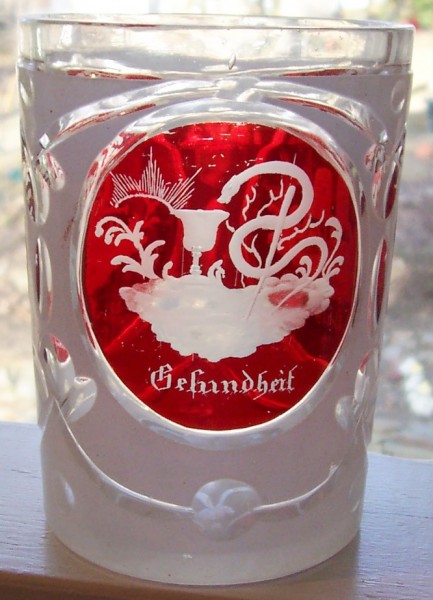
[FWTD] GERMAN TO ENGLISH MEANINGS – IN ORDER SHOWN:
“GLUCK” = LUCK / HAPPINESS / FORTUNE [ALL THE BEST], CORNUCOPIA WITH FLOWERS
FREUDE” = JOY [PLEASURE]; LYRE (STRINGED MUSICAL INSTRUMENT) AND FLOWERS.
“GESUNDHEIT” = HEALTHINESS / WELL BEING [WITH A CHALICE, SNAKE AND SHAFT], ALSO= SALUBRIOUSNESS = SPIRITUAL WELL BEING
“FLEISS” = INDUSTRIOUSNESS [DILIGENCE]; WITH OLD STYLE MAN-MADE BEE HIVES.
‘U (UND) FREUDE” = JOY / PLEASURE / AND FUN. SEVERAL HORNS, MUSIC AND LYRE
‘GESUNDHEIT” = SALUBRIOUSNESS [SPIRITUAL WELL BEING], SUN’S HALO AND RAYS ARE ASSUMED TO BE “SUN RISING”
‘GESUNDHEIT” = (AS OTHERS ABOVE) SALUBRIOUSNESS
“GLUCK” = LUCK / HAPPINESS / FORTUNE [ALL THE BEST] – ALMOST THE SAME DESIGN – CORNUCOPIA WITH FLOWERS
“FREUDE” = ALMOST IDENTICAL SCENE AS ON BEAKER ONE. LYRE (STRINGED MUSICAL INSTRUMENT) AND FLOWERS = JOY [PLEASURE]
“GESUNDHEIT”; WITH CHALICE = MEANING AS ABOVE
“GLUCK” = CORNUCOPIA WITH FLOWERS AND GRAPES, MEANING AS ABOVE.
“U (UND) FREUDE” = WITH LYRE, HORN AND MUSIC SHEETS. MEANING AS ABOVE
END OF THE FOUR BEAKERS SET [ALL FWTD]
An 11 inch tall (1.5 liter) beer stein with a set-on-lid. Ca. 1865. This is being credited due to the almost exact similarity of the ruby stained hop’s leaves on the borders when compared in texture and design to other known Josephinenhütte pieces. [FWTD]
For more info on these symbols, please see: “Fellowship symbols on ruby cut-to-clear glass drinking vessels.” http://www.steveonsteins.com/ruby-cut-to-clear-fellowship-symbols-1
.
SO CALLED “SPA CUPS” –
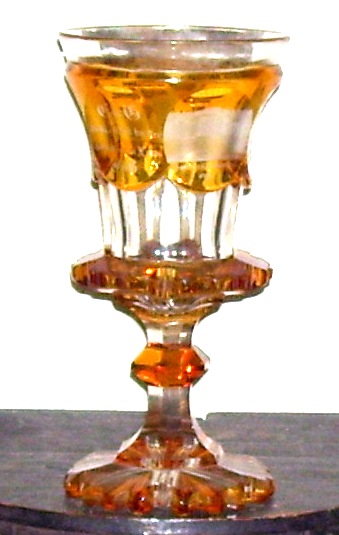
Yellow stain over clear glass.The top body circles may have been decorated later by a local engraver. 8 Inches tall. Circa 1845. For a similar example, see Ill.11, page 121. [FWTD]
CLEAR CUT GLASS POKALS
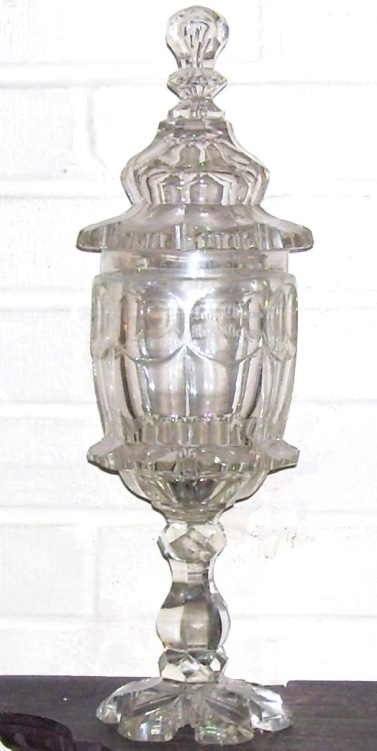
17 1/2 inches tall. For similar example, see Ill. 54, page 164. [FWTD]
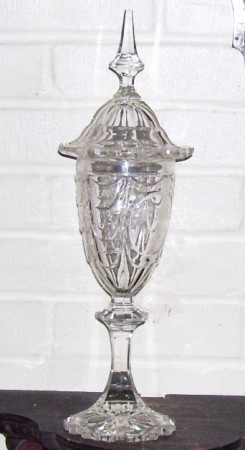
Pokal with heavy cut “hanging drapery” pattern around the top of the body. 17 Inches tall. For “very similar” examples, see Ill. 172, page 201, and Ill. 17, page 126. [FWTD]
RUBY STAINED, CUT TO CLEAR POKALS
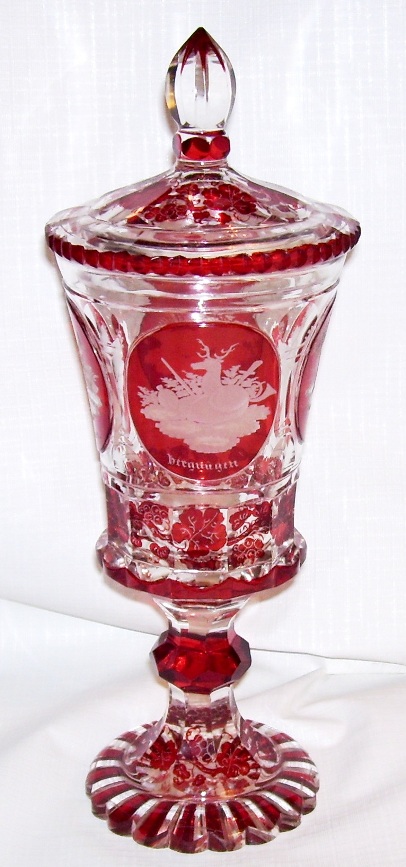
Friendship / religious symbols engraved around the body. 12.5 inches tall. Circa 1850-60.12.5 inches tall. For a similar example, see Ill. 147, page 187, and for the supplemental red leaf design, see Ill. 162, page 196.[FWTD]
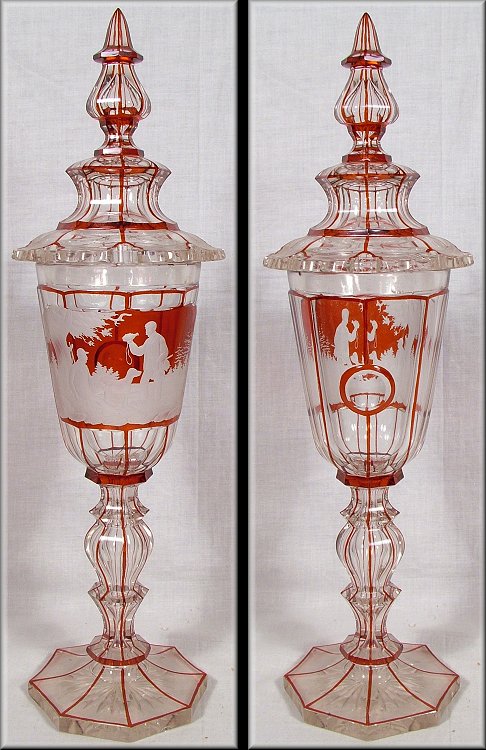
Scene of two men out hunting, resting, and drinking. Circa 1850. 16.5 inches tall. For a similar example, see Ill. 163, page 196; it is an almost identical lid design. [FWTD]
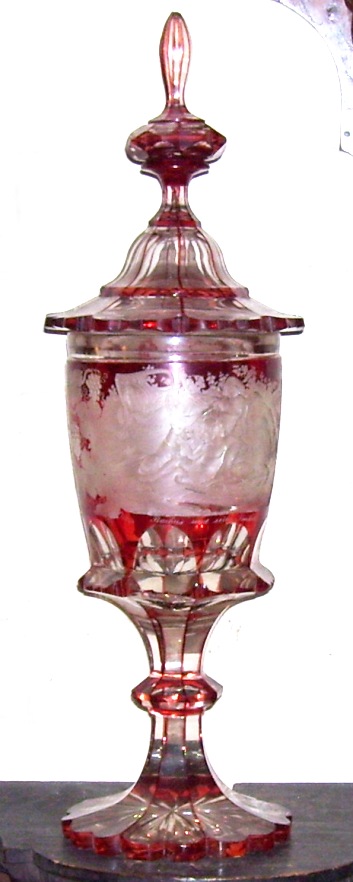
Bacchus and his gang. The very large engraved scene shows Bacchus and some of his women followers, along with two of his pet leopards which are often seen pulling his chariot. 17.5 inches tall. Circa 1850 -60. For a similar example, see Ill. 239, page 236. [FWTD]
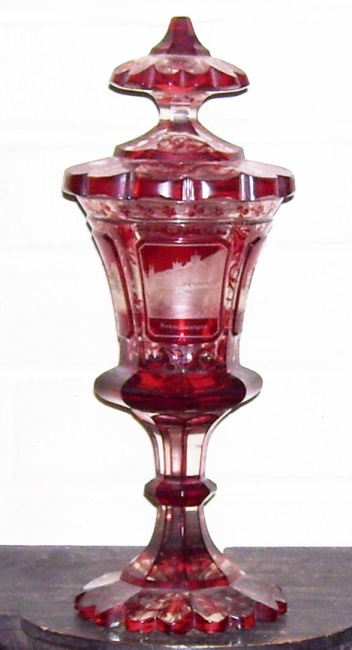
Building scenes. 12 1/4th inches tall. Circa 1850. For a similar example, see Ill. 147, page 187. [FWTD]
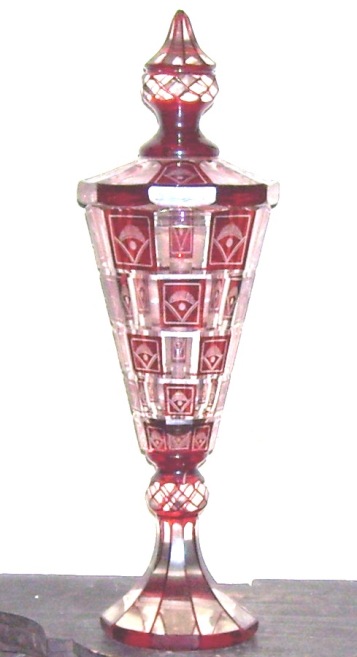
Art Deco (Jugendstil) style. 14 3/4 inches tall. Circa 1915-20. This is “quite possibly” a Josephinenhütte piece. As the referenced book only goes to 1900, it has no comparable examples at this time. [FWTD]
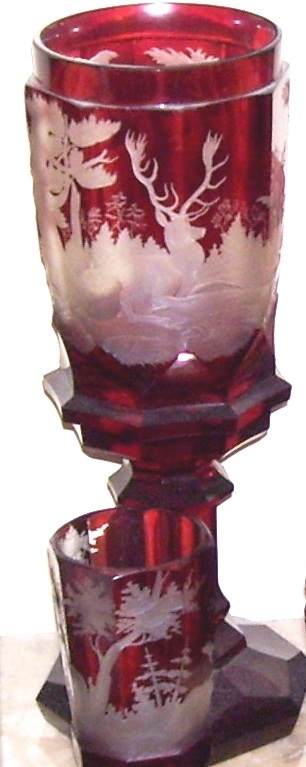
And here (to the rear of the smaller beaker) is the one drinking vessel in the collection I favor the most! Look at the sides to see how deep the “intaglio” cutting is! I only wish I could find the right sized lid. 15 1/2 inches tall. Circa 1860. For “very similar” examples, see Ill. 74, page 153, and Ill. 240, page 236. [FWTD]
OTHER CUT TO CLEAR POKALS
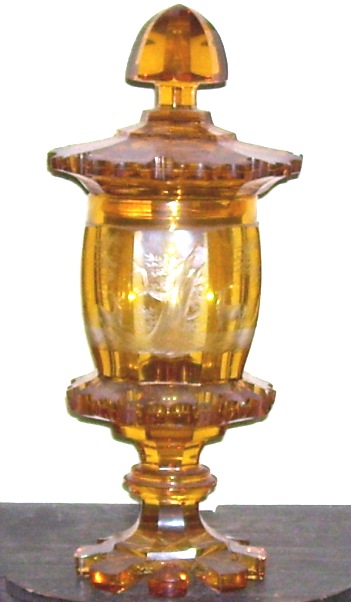
Animals . 11 1/4 inches tall. Circa 1845. For an “extremely” similar example, see Ill. 7, page 118., and Ill. 70, page 151.[FWTD]
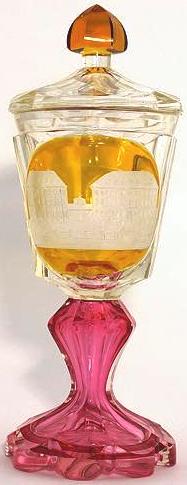
Building scene. A very probable Josephinenhütte pokal due to the flat cutting off of the bottom of the finial. This was one of their famous ‘cuts” on their pokals – see both examples above. 11 3/4 inches tall. Circa 1845. For similar examples, see Ill. 15, page 124, and Ill. 17, page 126. [FWTD]
Another web site with a few Josephinenhütte pieces shown: http://sites.google.com/site/bohemianglassandmore/josephinenhuette
And assuming their references are valid, then S’s M &T has one more piece.
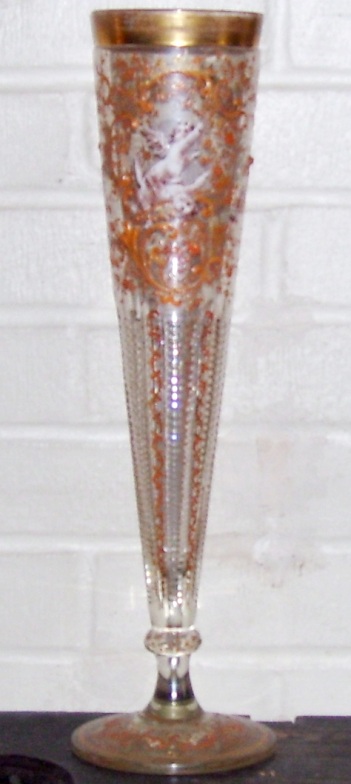
A 15 inches tall blown glass “flute” with small horizontal cuttings on the bottom half of the body with gold enamel and a scene of a painted cherub. [FWTD]
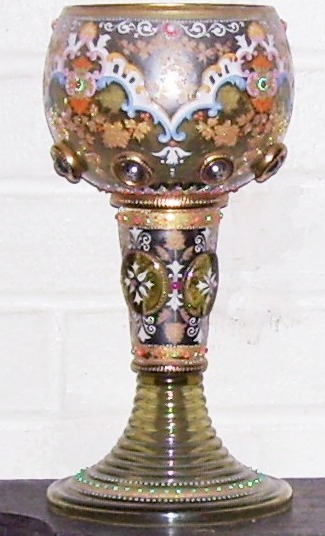
Another one of a pair, made as wedding gifts.
.
Now, above, the “Mother of all Roemers.” What this piece (really a pair here at the S M & T) doesn’t have I do not know! It has a ribbed stem, about four major enameled colors designs, the white enameled dot pattern, applied green glass dots at the bottom, large enameled prunts with smaller round in round prunts, a serrated enameled glass ring above the gilded enameled ring with applied green and red glass dots, crushed gold leaves and a gold ringed lip! Plus a small amount of silvering to form a reflective surface. I am now (end of 2012) not at all certain these were custom made for a marriage by Theresienthal glashütte in Bavaria. (All the colors look more TH than Josephinenhütte, but I can find no other examples of the round in round,gilded nipple prunts on other TH work. But who really cares?) Circa 1875-85 [FWTD]
[END – SOK – 38 – 3D]
WISH TO CONTACT ME? STEVE (STEPHEN) =
 “I have only met four really intelligent people in my life. I wasn’t impressed with any of them.”
“I have only met four really intelligent people in my life. I wasn’t impressed with any of them.”

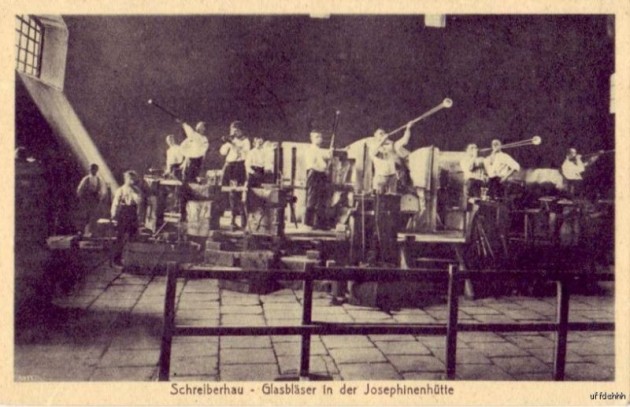
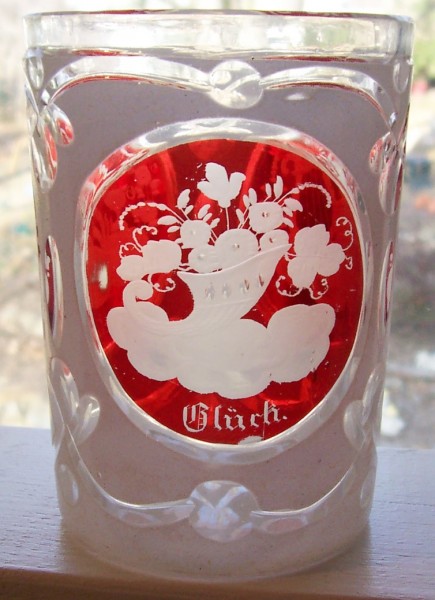
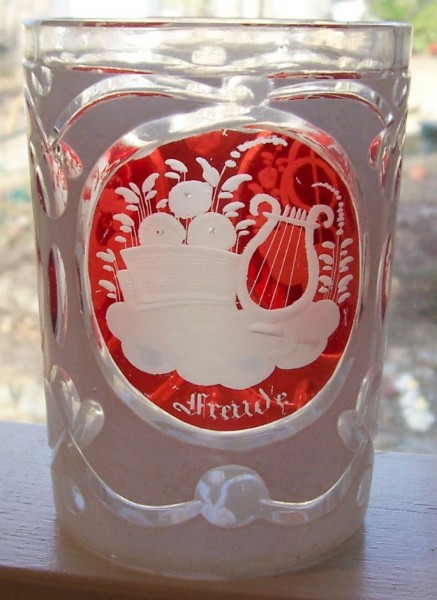
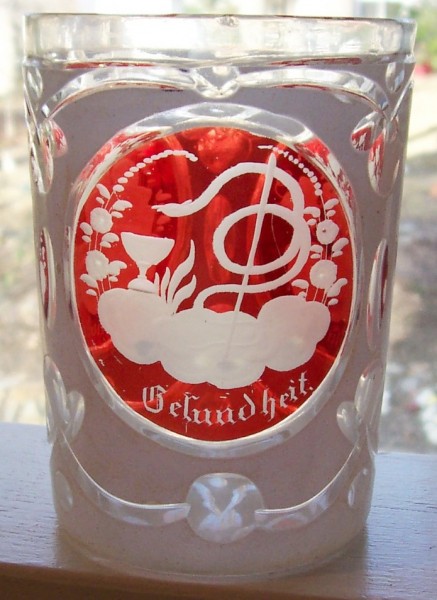
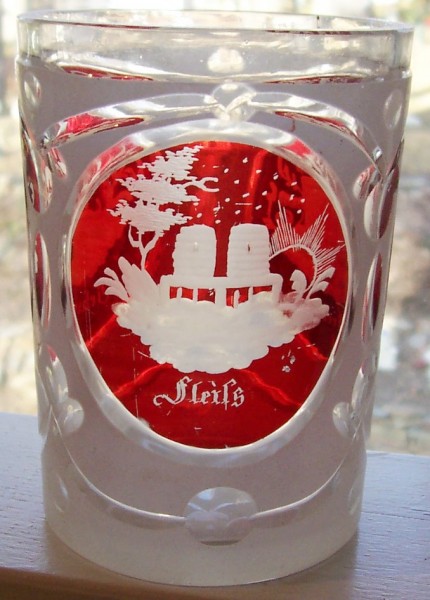
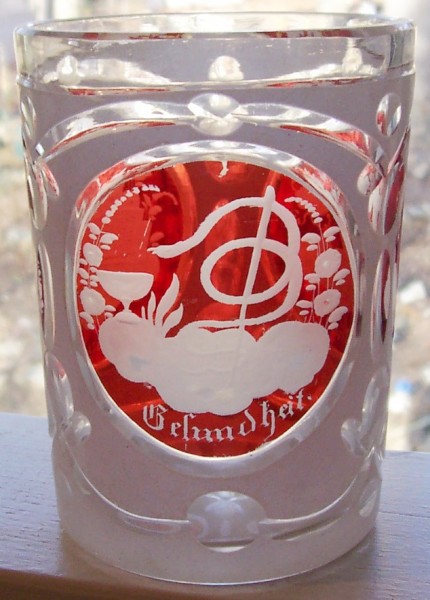
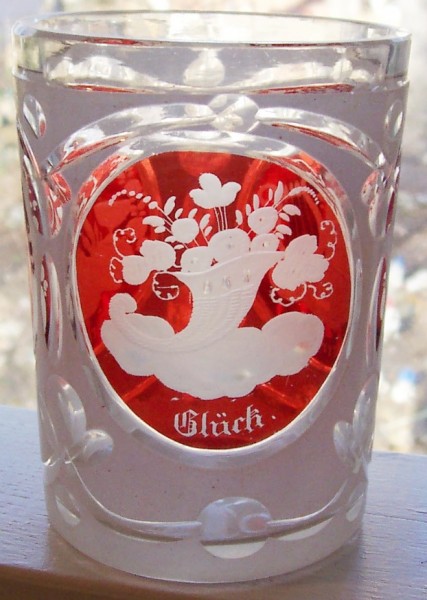
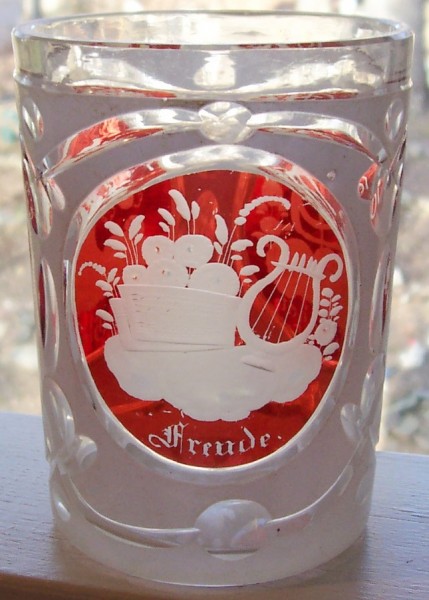
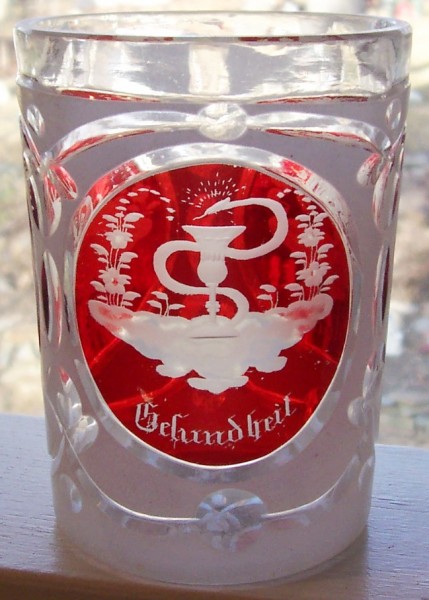
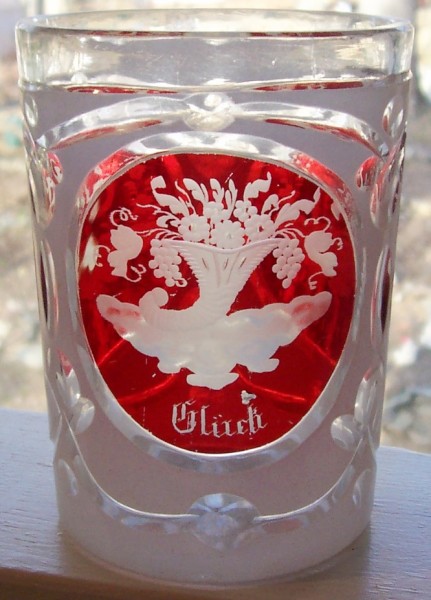
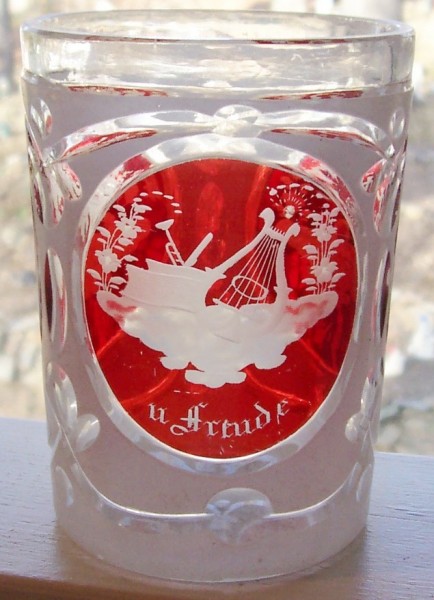
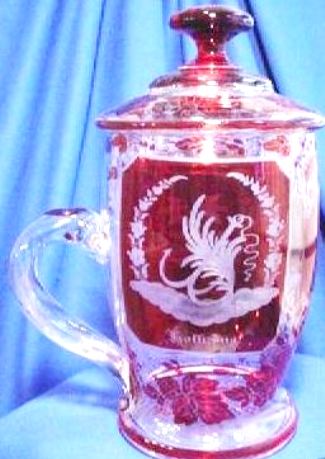
Leave a Reply